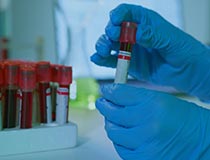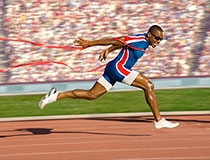If you experience a muscle, bone or soft tissue injury, your first thought might be to seek a prescription from your doctor for pain medication or get surgery. However, did you know that your body's natural healing abilities can be leveraged to treat your injury?
Orthobiologics is a field of medicine that focuses on harnessing the body's natural healing processes to treat injuries such as torn ligaments and broken bones. Using substances derived from your body, orthobiologics can help promote healing and reduce pain.
This article provides insights into orthobiologics: What they are, what they can do and which injuries they can treat.
A Closer Look: What Is Orthobiologic Treatment?
Orthobiologics are a type of biologics, or tissue-derived substances, specifically used to treat musculoskeletal conditions, hence the prefix ortho. Meanwhile, orthobiologic treatments are a form of regenerative medicine that uses orthobiologics to stimulate the body’s natural healing abilities and restore tissue that’s been damaged by injury, illness or aging. Widely considered a breakthrough in sports medicine, orthobiologic therapies offer reduced recovery times, pain relief and other benefits for patients with orthopedic conditions.
Determining how orthobiologics works will depend on the type of product used for the injury treatment. Below, we list examples of various orthobiologic treatments:
Cell Therapy
This orthobiologic therapy involves using live cells to treat, repair or regenerate damaged tissues in the body. Cell therapy can be autologous, meaning the cells used come from the patient’s body, or allogeneic, meaning the cells used come from a donor. In autologous cell therapy, the cells are typically harvested from the patient’s bone marrow or adipose tissue.
Viscosupplementation
Hyaluronic acid is a gel-like, slippery substance produced by and found throughout the body, particularly in the eyes, skin and joints. It has many essential functions, including lubricating joints and serving as a shock absorber, helping bones move against each other painlessly and without injury.
In viscosupplementation, hyaluronic acid is injected into joints to relieve pain caused by musculoskeletal injuries or conditions like arthritis.
What Are the Benefits of Orthobiologic Treatment?
A growing body of research supports the effectiveness of orthobiologics as a treatment for various injuries and conditions affecting the bones, joints, muscles and soft tissues. For instance, a study found that 93% of participants who received injections had good bone growth around the nail. In comparison, only 80% of the group that underwent intramedullary nailing showed good bone growth.
Orthobiologics are typically recommended if other treatment types have proven ineffective or if the patient wishes to avoid surgery. As an injury treatment, orthobiologics therapies offer the following benefits:
- Pain relief and reduced inflammation
- Supports healing and regeneration
- May help delay or avoid surgery
- Minimally invasive
- Faster recovery time compared to surgery and other conventional treatments
- Natural approach, since this injury treatment uses substances from the patient’s own body
What Conditions Benefit From Orthobiologics?
A wide range of injuries and conditions can benefit from orthobiologic therapies. These include the following:
Osteoarthritis
Osteoarthritis is a degenerative joint disease and the most common kind of arthritis. While it is common in older people, anyone can get osteoarthritis at any age. Young people may develop osteoarthritis due to injuries to the joint, a genetic defect in the joint cartilage or an abnormal joint structure. Additionally, women are more likely to develop osteoarthritis than men. Symptoms of osteoarthritis include:
- Pain while using the affected joint
- Stiffness when moving the joint
- Inflammation in and around the joint
- Reduced mobility in the joint
Traditionally, osteoarthritis is treated with one or a combination of the following:
- Lifestyle changes, such as losing weight and exercising regularly
- Pain relievers
- Non-steroidal anti-inflammatory drugs (NSAIDs)
- Capsaicin cream, if topical NSAIDs prove ineffective
- Steroid injections
- Physical therapy
- Surgery (joint replacement, joint fusing or osteotomy)
Your doctor may recommend orthobiologic therapies if conventional treatments don’t provide the desired results. Research suggests that orthobiologics are helpful for treating pain, stiffness, limited mobility and other symptoms caused by osteoarthritis. They may slow down joint degeneration, facilitate healing and improve function, allowing patients to delay or even avoid major surgery.
Tendinopathies and Ligament Injuries
Tendinopathies are conditions that cause pain and inflammation in the tendons. They have many possible causes, such as overuse, bone spurs (for heel tendinopathy), high-intensity training and placing too much weight on the tendon, such as when heavy lifting. Meanwhile, ligament injuries can be acute or result from overuse or illness. One example of a ligament injury is an anterior cruciate ligament (ACL) tear.
Both tendinopathies and ligament injuries can limit a person’s physical abilities, and if left untreated, they can result in chronic pain and reduced quality of life. Orthobiologic treatments have been shown to promote the healing of tendons and ligaments, reducing pain and improving function.
Fracture Healing
Bone fractures can take weeks to months to heal, especially in severe or complicated injuries. Orthobiologics can help accelerate the healing process by providing the necessary proteins and growth factors needed for bone repair. In some cases, orthobiologic treatments may even help patients avoid surgery or reduce the need for additional surgeries.
Back Pain
Many conditions that cause chronic or severe back pain can be managed with the help of orthobiologics therapies. As an injury treatment, orthobiologics can provide lasting relief from pain and improve other symptoms of conditions that cause back pain, such as:
- Scoliosis and spinal curvature
- Spondylolisthesis
- Degenerative disc disease
Orthobiologic therapies are also used to accelerate and support healing after surgery on the spine.
Explore Orthobiologic Treatments at Chicago Cell Therapy
Orthobiologic treatments have revolutionized how orthopedic conditions and injuries are addressed. These therapies can reduce pain and inflammation by harnessing the body's natural healing capabilities, even when conventional treatments fail to work. Importantly, they can make invasive approaches, like joint replacement, unnecessary.
Chicago Cell Therapy & Regenerative Medicine is a pioneering medical facility offering advanced and comprehensive treatments . It is led by Dr. Benjamin Domb, a nationally recognized orthopedic surgeon specializing in sports medicine. Please call (630) 920-2323 to learn more about our treatments. You may also request an appointment by filling out our online form. We look forward to being your partner in healing and recovery.


 Thanks a lot for getting my hip right. Looking forward to a full recovery and a great season. Thanks again for everything.
Thanks a lot for getting my hip right. Looking forward to a full recovery and a great season. Thanks again for everything.










